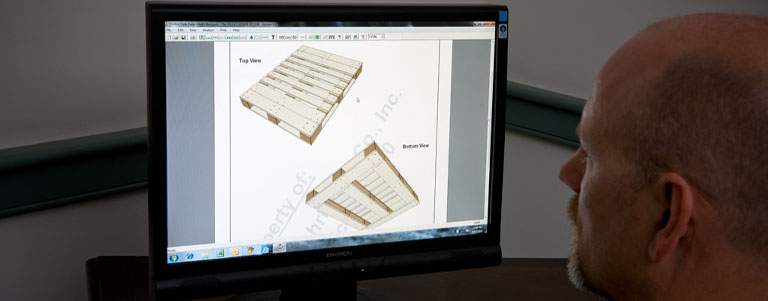Every industry has specific pallet needs; a food manufacturing company, for example, needs pallets with different stability requirements than a brick company. Businesses that ship pharmaceuticals must contend with the cost associated with single use pallets due to sanitation considerations. How you stack pallets during storage and shipping depends in part on the design of the pallet.
There are many variables that should be considered in pallet design, and optimizing them will result in a cost-efficient solution for your business. The best way to do this is by taking advantage of your pallet providers Pallet Design System (PDS) software. The beauty of PDS is in its ease of use and specificity. Pallet users define their entire load handling requirements and send the data file to their pallet provider. The provider then uses PDS to design a cost-effective pallet that meets all the requirements.
Pallet Design System (PDS) and Your Bottom Line
The PDS is a program developed at Virginia Tech on behalf of the National Wood Pallet Container Association (NWPCA) and is available for use by any of its members. The development of the program is ongoing, with a lot of research dollars going towards keeping it up-to-date. Ultimately, the reason for the investment on the part of pallet manufacturers is its utility to their customers. PDS is a critical piece of the industry because it enables designers to better meet the demands of specific products.
For storage and shipping, products are combined on a pallet to create a unit load. Each individual item is positioned in an interlocking fashion and bound together on the pallet in order to create a single unit that can pack tightly into storage and shipping space. The PDS program analyzes the production of a unit from start to finish: how the unit load fits on top of the pallet, how everything connects together and how it moves through the conveyor system. Maximizing the number of containers that can be safely included in the unit load and minimizing the cost of materials can save companies a lot of money.
How PDS Works
The first step in the process is the communication of unit load handling and support requirements from the pallet user to the pallet designer. The most reliable way to do this is for the pallet maker to visit the pallet user to examine the load, load support and handling conditions that the pallet will be required to bear. This information includes pallet size, multiple or limited use designation, container type and material, number of units and layers per load, and weight and height of the load. This information is then used by the PDS to create pallet specifications, drawings and analysis results that can be shown to the pallet user.
The PDS software enables pallet manufacturers to study the impact of cost-saving measures on the performance of the pallet. They can see how different wood types and board thicknesses impact the stability of the pallet with the unit load on top of it. This capability is invaluable to pallet users because it helps them determine the relationship between cost and quality and find the optimal compromise between the two.
